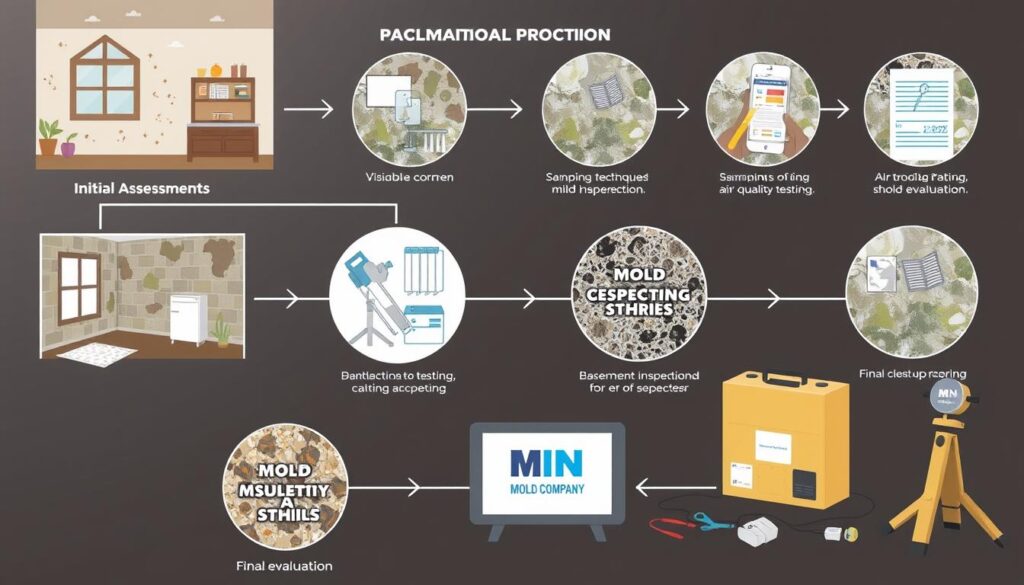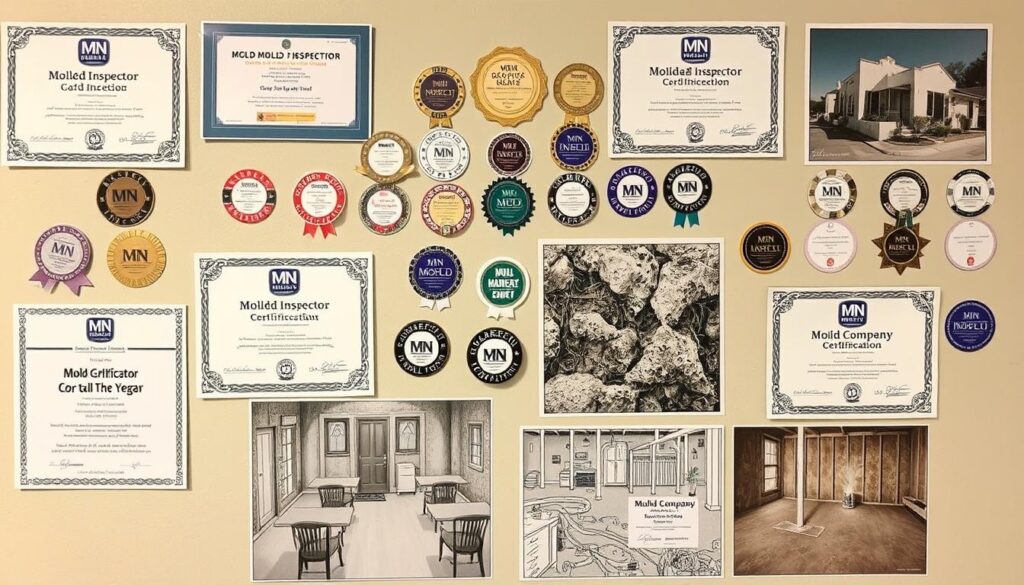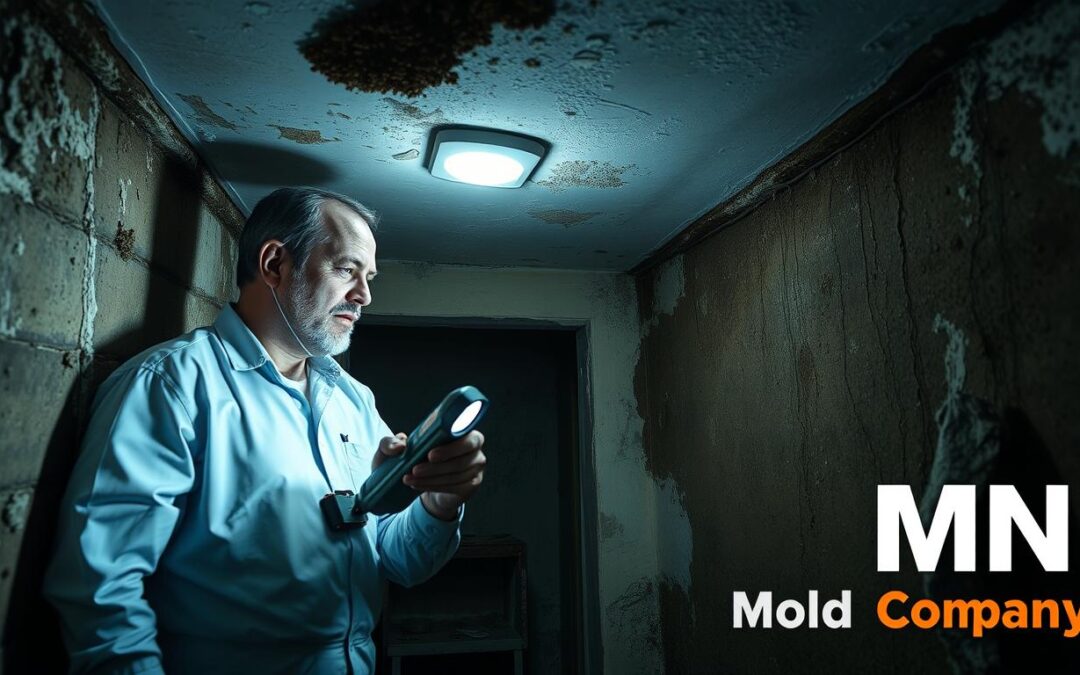As a property owner, mold is a big threat to your space. Regular mold testing is key. But, not all mold testing companies are the same. Many mold remediation companies now offer testing, which can be a problem.
This article will explain how these services work. It will also tell you what to look for when choosing a mold testing provider.
But have you ever wondered why an unbiased mold inspection is so important? What risks come with a biased assessment? How can you get accurate and reliable results? Let’s explore the truth about independent mold inspections.
Key Takeaways
- The importance of impartial mold testing to avoid conflicts of interest
- Drawbacks of combining mold inspection and remediation services
- How independent mold inspections work and the benefits of unbiased assessments
- Regulatory efforts to ensure mold testing impartiality
- What to look for when choosing a qualified mold inspector
The Importance of Impartial Mold Testing
Ensuring your home’s safety and health is key. Why unbiased mold inspections are crucial. Companies that test and fix mold might find mold to make money. This can make their test results seem biased.
Biased Test Results: A Conflict of Interest
Independent mold inspections are more reliable. These experts don’t benefit from fixing mold. They give honest, unbiased reports that focus on your safety.
Lack of Transparency in Reporting
Company-affiliated mold inspections might not share all details. This lack of openness can hide the true mold problem. It makes it hard to decide on the right fix.
Choosing an independent inspector means a thorough, unbiased check. They aim to protect your family’s health with the best solution.
“Unbiased mold testing is essential for ensuring the safety and health of your home. Independent inspections provide a clear, transparent assessment that prioritizes your best interests.”
Drawbacks of Combining Mold Inspection and Remediation
Understanding the downsides of hiring a company for both mold inspection and remediation is key. These firms might suggest more expensive fixes, even if they’re not needed. This could cost you more than necessary.
Remediation Companies’ Financial Incentives
Companies that do both inspections and remediation might want to find a lot of mold. This is because finding a lot means they can make more money from the fix. This creates a problem because the inspector should just give a fair view, not try to make more money.
Pushing Unnecessary Services
These companies might suggest you need more work than you really do. They might do this to make more money. Independent mold inspections can protect you from this. They make sure you only pay for what you really need.
| Mold Inspection and Remediation | Independent Mold Inspection |
|---|---|
| Potential conflict of interest, as the inspector may have a financial incentive to find more extensive mold growth. | Provides an unbiased assessment of the mold situation, without any financial incentive to recommend unnecessary remediation work. |
| Remediation company may push for more extensive (and costly) mold removal than what’s truly needed. | Helps homeowners identify the most appropriate and cost-effective remediation services to address the mold problem effectively. |
“Independent mold inspections can help protect homeowners from potential conflicts of interest and ensure they receive the most appropriate and cost-effective remediation services.”
Independent Mold Inspection
An independent mold inspection is key when dealing with mold in your home or building. It gives you a clear view of the mold problem without bias. This way, you can decide the best steps to fix it.
Independent mold inspections are thorough and fair. They include:
- Gathering background information about the property and any known mold issues
- Conducting a comprehensive visual inspection to identify areas of concern
- Collecting samples for laboratory analysis to determine the type and extent of mold growth
- Providing clear and detailed recommendations for appropriate remediation measures
Choosing an independent mold inspection means you get unbiased information. This helps you make the best choices for your property and health.
“An independent mold inspection is the only way to truly understand the extent of the problem and ensure that the remediation process is handled properly.”
Independent mold inspection services offer many benefits. These include:
- Accurate and Transparent Findings – You can trust the inspection report for a fair view of the mold situation.
- Informed Decision-Making – Knowing the mold problem well, you can choose the right remediation steps and contractor.
- Compliance with Regulations – Inspections ensure mold remediation follows local and state laws, keeping your property safe.
Going for an independent mold inspection means you’re taking the right steps to fix the mold issue. You can rest easy knowing your home or building is being taken care of.
How Independent Mold Inspections Work
Understanding mold issues in a property needs a detailed, unbiased inspection. An independent mold inspection includes a background check, a site visit, and sampling and analysis. These steps help identify mold problems accurately.
Background Information and Site Visit
The first step is to gather background info on the property. The inspector looks at any water damage, flooding, or past mold growth. This helps pinpoint potential problem spots.
During the site visit, the inspector walks through the property carefully. They check all areas for mold or moisture signs. This includes hidden spots like behind walls and under floors. The inspector notes the mold’s extent and location.
Sampling and Analysis Procedures
To find out the mold types and how widespread it is, the inspector takes samples. These are then analyzed at an independent, accredited lab.
The lab identifies the mold species and gives a detailed report. This info is key for a good cleanup plan. Different molds need different treatments. The mold inspection process aims for a complete, unbiased assessment, setting the stage for effective cleanup.

Regulatory Efforts to Ensure Impartiality
States have stepped up to address concerns about mold testing conflicts of interest. They’ve passed laws to make sure mold inspections are fair and open. This protects homeowners from unfair biases.
State Laws and Regulations
States now require mold testing companies to get certified by outside groups. This step checks if inspectors are qualified and can give unbiased reports.
Also, many states won’t let mold remediation companies test properties they’ve worked on before. This rule stops the conflict of interest that comes from one company doing both the test and the fix.
| State | Regulations on Mold Testing and Remediation |
|---|---|
| California | Requires mold inspectors to be licensed and accredited by the state. Prohibits remediation companies from conducting testing on properties they have previously worked on. |
| Florida | Mandates that mold testing be conducted by an independent, licensed professional with no financial ties to the remediation company. |
| New York | Bans mold remediation companies from offering mold testing services, ensuring a clear separation between the two services. |
These rules help states ensure how regulations ensure impartial mold inspections and state laws on mold testing and remediation. They protect homeowners from unfair practices and make sure mold assessments are trustworthy.
Choosing a Qualified Mold Inspector
When you need to hire a mold inspector, it’s important to find one with the right credentials. Look for professionals who have been recognized by groups like the American Council for Accredited Certification (ACAC) or the Council of Engineering and Special Sciences Board (CESB).
Accreditations and Certifications to Look For
These credentials show the inspector knows their stuff and follows the best practices. This means you can trust the results. When hiring an independent mold inspector near me, check for these certifications:
- ACAC Certified Microbial Investigator (CMI)
- ACAC Certified Mold Remediation Supervisor (CMRS)
- CESB Certified Indoor Environmental Consultant (CIEC)
- CESB Certified Indoor Environmentalist (CIE)
These characteristics of a qualified mold inspector show they are serious about their work. They follow the rules of the industry. This is key when how to find an independent mold inspector to check your place.
| Certification | Issuing Body | Focus Area |
|---|---|---|
| CMI | ACAC | Microbial Investigation |
| CMRS | ACAC | Mold Remediation Supervision |
| CIEC | CESB | Indoor Environmental Consulting |
| CIE | CESB | Indoor Environmental Assessment |

Choosing a mold inspector with these credentials means you can trust them. They will give you a fair and detailed look at your indoor air and any mold problems.
Types of Mold Testing Methods
Finding out if mold is in a building is key to keeping people and structures safe. There are many ways to test for mold, each with its own benefits and drawbacks. Knowing about these methods helps ensure you get accurate results.
Air sampling is a common method. It collects air from the area to check for mold spores. This can show how much mold is in the air and where it might be.
Surface sampling looks at surfaces like walls and floors for mold. It’s great for finding out what kind of mold is there and how bad it is.
Bulk sampling takes a bigger piece of material, like drywall, for a detailed check. It helps find where mold is coming from and how far it has spread.
| Mold Testing Method | Advantages | Limitations |
|---|---|---|
| Air Sampling |
|
|
| Surface Sampling |
|
|
| Bulk Sampling |
|
|
Newer methods, like DNA testing, give even more detailed info on mold types. They help understand health risks better.
A skilled mold inspector can pick the best test for your property. Knowing about different tests helps make smart choices to fix mold problems.
Cost Considerations for Mold Inspections
When you’re worried about mold in your home or business, the cost of inspections matters a lot. The price can change a lot based on several important things.
The size of the property is a big factor. Bigger places need more tests, which means higher costs. Also, how many samples are taken can raise the price, since each one costs more.
The method used for testing also plays a role. DIY mold testing kits are cheap, costing between $10 to $50. But, they might not be as accurate or detailed as professional mold inspections. These can cost $300 to $600 or more, depending on the job.
| Mold Inspection Type | Average Cost |
|---|---|
| DIY Mold Testing Kit | $10 – $50 |
| Professional Mold Inspection | $300 – $600+ |
Even though mold inspections can be pricey, they’re worth it. A good, unbiased assessment can prevent expensive and dangerous mold fixes later. Knowing what affects the cost helps you choose wisely and make sure your place is checked for mold.
What to Expect During a Mold Inspection
Getting a mold inspection is key to dealing with mold problems in your home. This process has several steps. They help find out how big the problem is and what to do next.
The Mold Inspection Process
Here’s what happens when you get a mold inspection:
- Initial Consultation: The inspector will first ask about your concerns. They’ll look for any mold, water damage, or moisture issues.
- Visual Inspection: Next, they’ll check the property thoroughly. They look for mold, water stains, and moisture sources.
- Sampling and Analysis: Based on what they find, they might take samples. These are then analyzed in a lab to find out what mold is there.
- Interpretation of Results: After the lab results come back, the inspector will explain them. They’ll tell you how much mold there is, what kind, and what to do about it.
The whole mold inspection process can take a few days to a week. This depends on how complex the inspection is and how long it takes to get the lab results.
Knowing what a mold inspection involves helps you deal with mold problems. It ensures your home is healthy and safe.
Benefits of an Unbiased Mold Assessment
Choosing an independent mold inspection company is key to getting accurate info about mold. This way, you can make smart choices about fixing the problem without being swayed by money or personal interests. An unbiased mold check keeps your property and family safe.
The main advantage of choosing an independent mold inspector is getting honest and reliable info. These inspectors don’t have a stake in the outcome. They give advice based only on the facts. This is different from mold remediation companies, which might overstate the problem to make more money.
Why an impartial mold assessment is important is it helps you make smart, budget-friendly choices. An unbiased inspector will give you a detailed report on the mold, its causes, and the best ways to fix it. This lets you pick the most effective and affordable solution without being influenced by biased advice.
- Receive accurate and transparent information about the mold problem
- Make informed decisions about necessary remediation steps
- Protect your property and the health of your family or tenants
- Avoid financial incentives or conflicts of interest that may influence the assessment
“An independent mold assessment provides the peace of mind that comes from knowing the full extent of the problem and the best way to address it.”
By picking an independent mold inspector, you can trust the info you get is fair and in your best interest. This method ensures a thorough and dependable check. It lets you take the right steps to fix the mold issue and protect your property and health.
Conclusion
Independent and unbiased mold inspections are very important. Choosing a qualified mold testing company that is not involved in remediation ensures accurate results. This way, you can trust the findings and recommendations are for your best interest.
This approach protects your home, family, and investment. It makes sure mold issues are handled fairly and effectively.
Transparency and no conflicts of interest are key. A mold inspection company not involved in remediation focuses only on solving the problem. This means their advice is not driven by profit.
Keeping your property safe and healthy is crucial. Addressing mold concerns with an unbiased assessment is a big step. By following the advice in this article, you can make smart choices. This will protect your investment and the well-being of your home.
FAQ
Why is it important to choose an independent mold inspector?
An independent mold inspector gives you honest info about mold in your home. They don’t have a financial gain from finding mold. This means you get unbiased results and clear information.
What are the drawbacks of using a mold remediation company for mold testing?
Companies that test and fix mold have a big reason to find mold. They want to sell you their services. This can lead to biased tests and hidden problems.
How do independent mold inspections work?
Independent mold inspections are thorough and fair. They look at your home, do lab tests, and give advice. You get clear info to make smart choices about fixing your home.
What are the steps in the mold inspection process?
First, there’s a meeting to discuss your home. Then, they visually check your home and take samples. These samples are sent to a lab for analysis. After, they explain the results and suggest fixes.
What should I look for when choosing a mold inspector?
Look for a mold inspector with the right certifications. Check for American Council for Accredited Certification (ACAC) or American National Standards Institute (ANSI) approval. This shows they’re skilled and follow best practices.
What are the different types of mold testing methods?
Mold testing can be done in many ways, like air, surface, or bulk sampling. Each method has its own strengths and weaknesses. The right method depends on your home’s needs and the test’s goals.
How much does mold testing typically cost?
Mold testing prices vary. It can cost between 0 and 0, or even more. The price depends on your home’s size, the number of samples, and the test type.
Source Links
- Residential Mold Testing: What Every Homeowner Should Know | Indoor Doctor Types of Mold Testing, How to Hire for Mold Testing
- Don’t Use the Same Company for Both Mold Inspection & Mold Remediation. Here’s Why…
- Mold Remediation and Mold Testing: Why You Shouldn’t Choose Companies That Offer Both | Indoor Doctor

